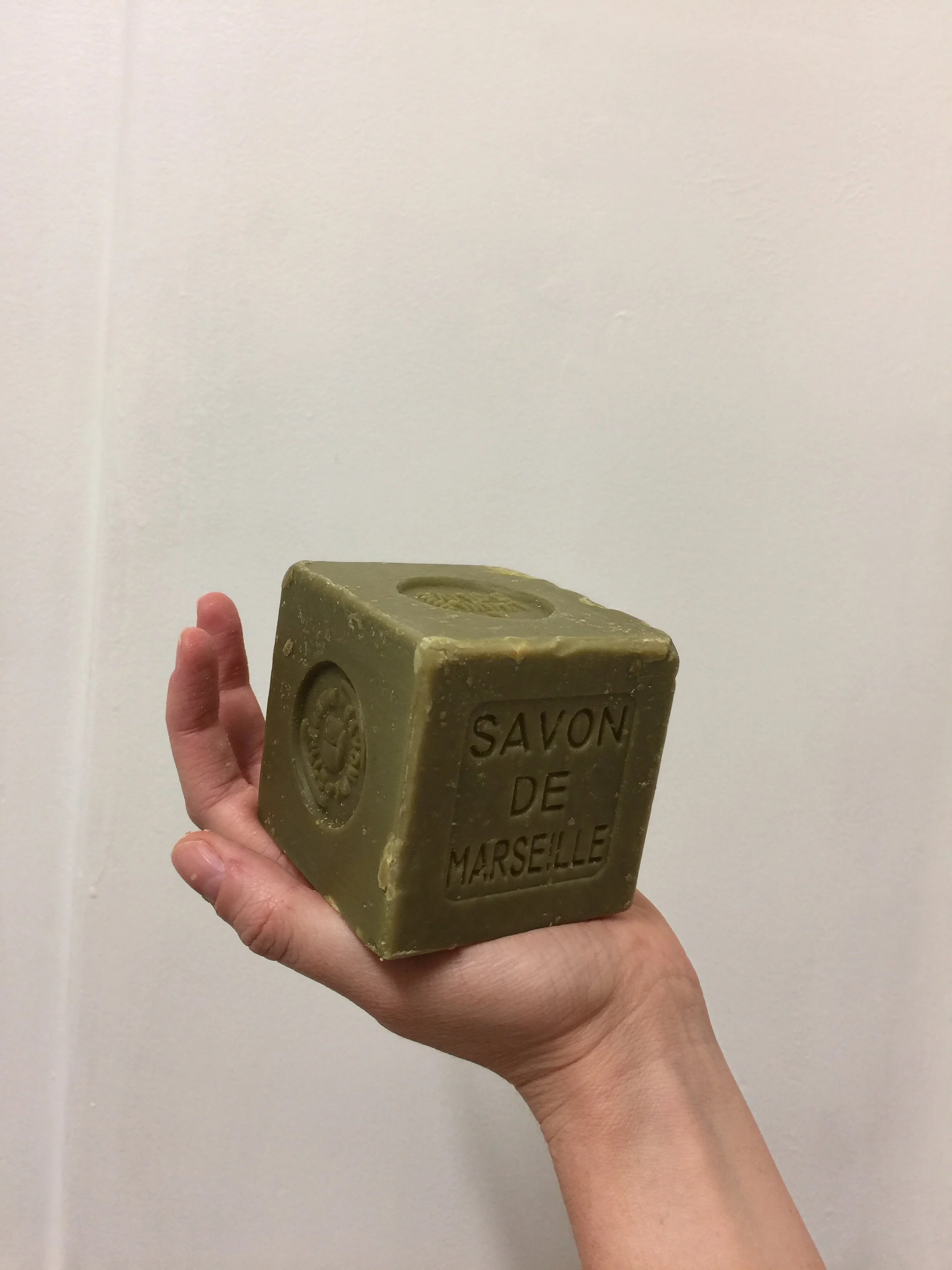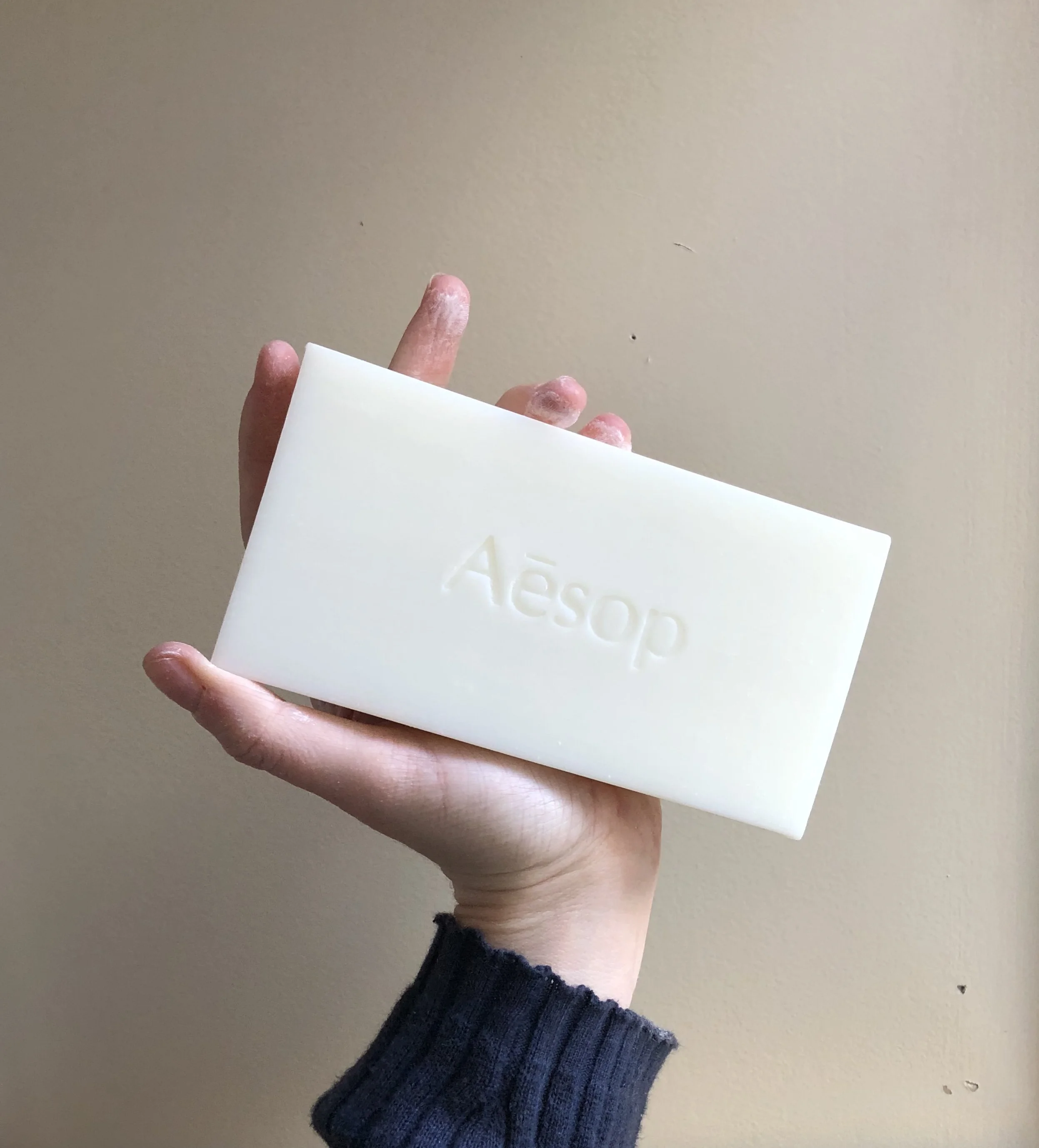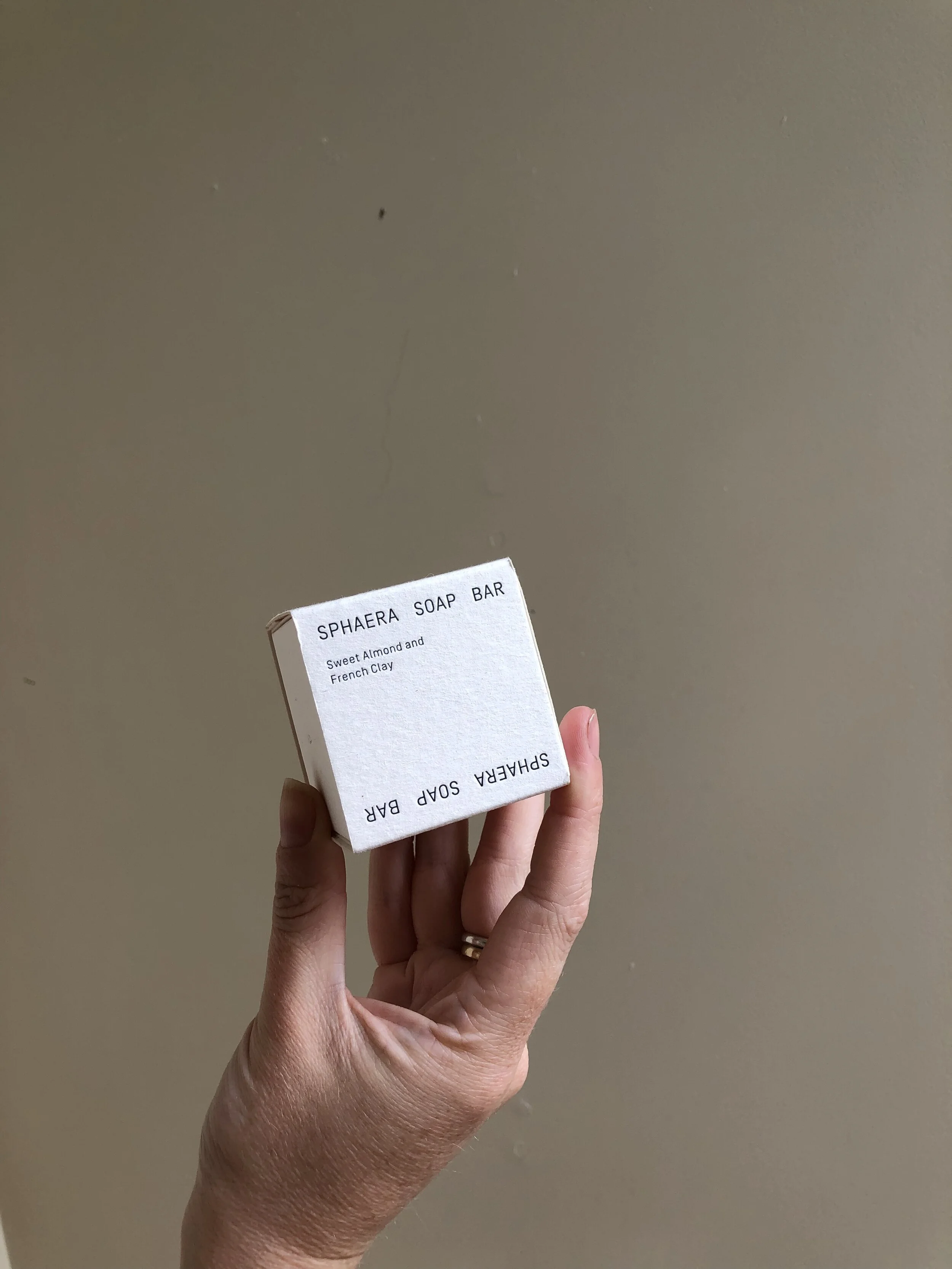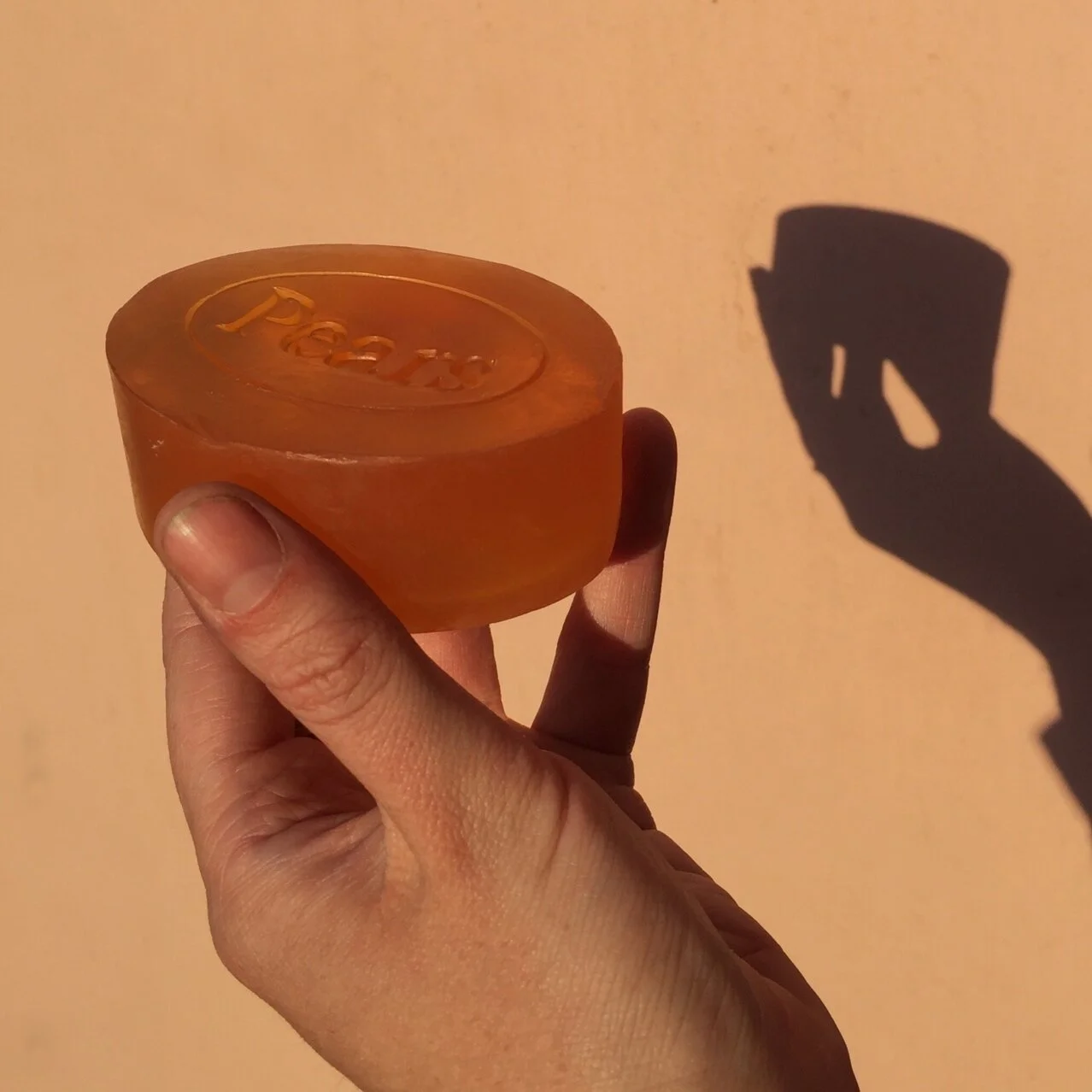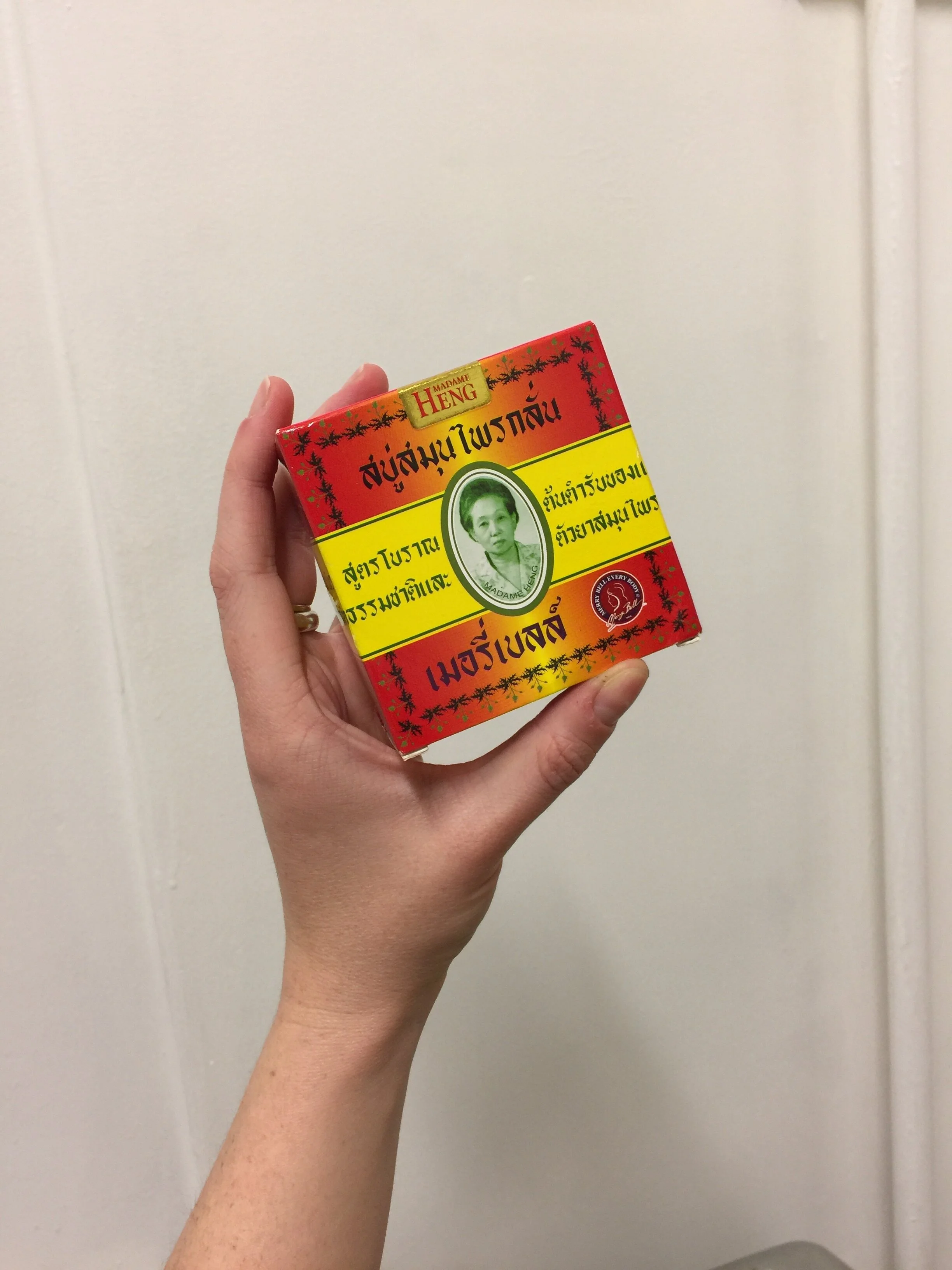Raise the bar
From an indulgent slab by Aesop to a hand-hewn chunk of Aleppo soap and the cheerful yellow nostalgia of Sunlight, Emma Gleason explores the sentimentality and science of bar soap and explains why it deserves shelf space in your bathroom.
Perched on the edge of the tub or in the shower, a bar of soap represents far more than just cleanliness. Its luminous opacity, smooth surface, and the modular practicality of its shape are reassuring in their blankness and purpose. There’s little in the way of branding, save for a stamped logo on a recently unboxed bar, soon to disappear. Soap offers up a calming slice of reassurance; it has remained relatively unchanged for decades, and still performs its original duty in the same way.
Washing is one of the simplest yet most soothing tasks a day can hold. Disconnected and alone, or not (bathing can be romantic or, for many cultures, a communal activity), it’s a moment to clean away sweat, stress and everything else that has happened. The rituals and methods of bathing vary widely around the world, but soap ties us all together — and bar soap is the oldest and most authentic of them all.
On a surface level at least, there’s something democratic and simple about soap. All bars are roughly the same shape and perform the same function. Cuboid or oval, they fit well in your palm, and have flat-ish surface planes that are slid across the body or lathered between hands — depending on your washing technique.
For all their similarities however, soaps can also vary widely. They are an item I often purchase when overseas, as they are representative of a place, culture and time.
I never actively set out to make acquiring soap a hobby of sorts, it just made sense; as a functional object they have a practicality that other decorative items lack. There’s also something pleasurable about the lifecycle of a bar — from the unwrapping and first pristine use, to the sense of achievement when it’s at long last reduced to a tiny nugget before ceasing to exist at all. Bar soap is simple and useful, attributes I value and appreciate.
Soaps I’ve used and enjoyed, or want to:
Marius Fabre Savon de Marseille: A large slab of this, green and softened with use, rested on the corner of my friend’s bathroom in Paris. I was transfixed. A day or two later we walked to the store it came from, and I purchased a heavy cube of it for myself for five euros. Wrapped simply in brown paper and emitting a rich olive aroma, I carried it around with me for months, before placing it on our bathroom shelf at home, where it sat quietly waiting for “the right time”. Over a year later the right time proved to be a pandemic when, confined to our tiny apartment and clinging to small joys and memories, I finally unwrapped it.
Aesop Body Cleansing Slab: This hefty bar is a monolithic addition to my shower. It smells fresh and mildly herbaceous, like all Aesop products. I like things that smell green. A little goes a long way, and the lather is creamy and lovely. It’s also rather satisfying to just look at, all smooth surfaces and sharp corners (for now).
Dr Bronner’s Pure-Castile Soap: I’ve been buying this fair trade, vegan, organic soap on and off for years, both in liquid and bar form. I prefer the brand’s unscented ‘baby soap’ due to its higher oil content. The brand’s soaps are touted as 18-in-one, though I only use mine in the shower. The packaging is a dense wall of text, oddly appealing with its earnest proselytising.
Sphaera Sweet Almond and French Clay Soap: The soap that’s all over the most tasteful local Instagram accounts — luminous, neat little cubes seen in considered bathrooms — Sphaera is the kind of small, women-led business that I like to support. Their packaging is excellent, as is the soap inside. I like their clay offerings best, but do want to try their laundry bar.
Pears Pure & Gentle Soap: This entry is delightfully translucent and nostalgic. While not the most natural or artisanal, there’s something mesmerising about its transparency and amber hue, not to mention the spicy, herby scent. I began using Pears again during the year we spent in India (it’s manufactured there, so it’s available everywhere) and it will always hold memories of that time for me.
Hasan Aleppo Soap: A small, family-run local business, the founders are from Syria and their bars are rustic, nourishing and divine. I was introduced to the brand by my mother, who bought me a couple of bars from her neighbourhood farmers’ market.
Ecostore Lemongrass Soap: I can’t pass up this fresh, zingy bar by Ecostore. It’s invigorating, especially in the morning, and also has a rather pleasing shape — a rectangular cuboid — and proportions.
Ethique Solid Shampoo: This local business makes bar shampoo and conditioner (and soaps) which were recommended by a fellow long-haired friend. I’ve been trying to cut back on plastic, so swapping to bar shampoo is the logical next step. I plan to buy some of theirs once I’ve run out of my current hair care.
Neutral 0% Soap Bar: This profoundly scentless white soap is recommended by the Danish Asthma and Allergy Association. I bought six bars of it in the Netherlands while my eczema was flaring up. It’s drastically plain and minimal to the point of austerity (which I love) and contains no fragrances, parabens or colourants so it’s good for sensitive skin like mine.
Ingrid Starnes Vetyver Bergamot Soap: With their heady aroma and beautiful floral paper packaging, these soaps make excellent presents — I am a big fan of practical-and-lovely when it comes to gifting. This soap does an excellent job of nourishing the skin as it includes goat’s milk, manuka honey and shea butter.
Sunlight Pure Soap: Another nostalgic bar that’s always in my cupboard; my mum uses it and so do I. Its sunny yellow hue and embossed logo of a child are infinitely cheerful. It’s also cheap. A household staple for decades, this multi-purpose soap is sold as a laundry bar, and I like to use it for hand-washing clothes. Local production ceased in 2003, and the bars available here in New Zealand are imported from Australia where it’s still manufactured — the cardboard packaging and old-fashioned branding are thankfully still in place. Interestingly, it apparently enjoys 75 percent of market share in Sri Lanka.
Madame Heng Merry Bell Soap: A soap from Thailand, I bought a few bars in Bangkok on the recommendation of a friend. This herbal soap is fresh and cooling. Designed for hot, tropical climates, it’s meant to help with skin blemishes and breakouts.
Curio Noir Tobacco Night Hard Soap: My favourite scent from this brand, I like this soap for the kitchen (and for gifts) as it exfoliates and combats odour well.
So, how is soap made anyway?
When it comes to bar soap, science begets art. Relatively simple, the key ingredients and process required to create ‘true soap’ remain rather unchanged. Hard soap is made through saponification, a chemical reaction caused by combining fatty acids like vegetable oil or animal tallow with water and sodium hydroxide (also known as lye or caustic soda, it dissolves completely during saponification). Left to cure and solidify, the result is a hard block composed of water, soap and glycerine. A byproduct of saponification, glycerine is a humectant, attracting moisture to hydrate your skin from both the environment and within.
The actual way soap cleans is often given little thought, but it’s worth understanding as it is quite miraculous considering how few ingredients are required to make a simple bar, and how old the soapmaking process is.
Soap is a surfactant, which means it lowers surface tension, and it is amphiphilic — both hydrophilic (water-loving) and lipophilic (fat-loving). Oil and water don’t usually mix, but soap loves both of these. Enhanced by the friction caused by the physical act of washing, soap emulsifies molecules by binding oil with water, separating the soluble grease and grime from the skin and enabling them to be washed away.
It’s all quite simple, yet also profoundly important given the impact successful hygiene practices can have. Soap kills microorganisms (like coronaviruses) by breaking the protective lipid layer and destroying the virus inside — for more on how that works, I encourage you to read RNZ’s clear and comprehensive explainer. Natural soap is just as successful as antibacterial soap in doing this, as it’s the soap itself that destroys these microorganisms.
How natural is natural?
Though lots of soap bars are marketed as ‘natural’ and indeed these are infinitely better for both our bodies and the environment, technically all soaps have to have gone through the chemical process of saponification to exist. Soap itself isn’t naturally occuring, so describing a soap as natural generally means that it was made from minimal, naturally derived ingredients like olive oil or coconut oil.
Many natural soaps include additional ingredients that are both beneficial and enjoyable — like exfoliants, fragrances and essential oils, clay, and activated charcoal. ‘Superfatted’ soaps boast excess oil or fat (these remain unsaponified) for their moisturising, enriching and emolliating qualities — such as Dr Bronner’s baby soap, which I love. Colloidal oatmeal can help soothe skin conditions. Goat’s milk can be used instead of water to mix with sodium hydroxide, and the milk’s nourishing bounty of saturated and unsaturated fats help retain the skin’s fatty acids and maintain its microbiome, while the lactic acid acts as a gentle chemical exfoliant. For anyone with sensitive or difficult skin, natural bar soaps are worth consideration.
When did lathering up begin?
Soap making is an ancient tradition. It is thought that as early as 2800BC the Babylonians boiled fat with ashes to create a soap compound to clean clothes. Body soap has a murkier history, and is generally thought to have originated in what was historically known as the Levant region (the eastern Mediterranean and western Asia). The Celts were also soapmakers, and introduced it to the Romans around 58BC (who previously employed an oil-and-scrape method of cleaning).
Soap for bodily washing became more common in Europe from the 2nd century AD. It was also an important industry in the Middle East; Levant soaps made from olive oil were much more appealing than those made from animal fat elsewhere, and subsequently were exported to Europe where they influenced soap making in regions like Marseille and Castile. The commercial soap industry in Britain was subject to monopolies, taxation and remarkably strict regulation for centuries. For those who really want to get lathered up in the story of soap making, a very comprehensive history can be read here.
Geographically named soaps of note
Marseille soap: Sold in hefty cubes and priced by weight, this soap has been produced in the coastal Marseille region in the South of France for around 600 years. Traditionally made from sea water and olive oil — the latter of which is naturally high in hydrating squalene and contains vitamin E and other antioxidants — this coveted and famous multi-purpose soap is hypoallergenic, anti-inflammatory, and nourishing. White versions are made from coconut or palm oil. Authentic soap from L’union des Professionnels du Savon de Marseille (founded in 2011) is stamped ‘Savon de Marseille’ and has no added fragrances, colourings or preservatives.
Castile soaps: These are made from vegetable oil rather than animal tallow, and are named after the region in Spain where the traditional method originated centuries ago — a process that uses brine to remove more impurities than other soap making methods, creating a hard, white bar. Though once a geographical identification, the name now generally refers to all white, vegetable oil based soaps.
Aleppo soap: Also known as Sabun Ghar or Savon d’Alep, and what many consider the oldest and the best soap, Aleppo soaps originated in the Syrian city of the same name, and indeed the wider region is considered the historical home of soap making. Considered one of the oldest soaps in the world, it influenced Castile and Marseille soaps. Much of the Aleppo soap industry has been ravaged by the war in Syria. The soap is made using a very traditional process — methodically poured, stamped and cut by hand — and videos of it are a soothing, informative watch and easy to find on YouTube. Genuine Aleppo soap is made from olive oil, laurel berry oil, water and lye. Laurel is naturally antimicrobial and antifungal. Traditionally Aleppo soap is matured for months, resulting in a rich layer of oxidisation on the outside of each bar. Similarly to Marseille soap and unlike other geographically named products like Champagne, the name ‘Aleppo’ is not subject to restrictions. Though it is now made all over the world, as with any culturally significant product it’s best to seek out Syrian manufacturers.
Nabulsi soap: Similar to Castile soap and made from olive oil, Nabulsi soap is very pure and very traditional, and only produced in the West Bank in Palestine. A camel can be found stamped haphazardly (in the best way) on the packaging.
What about all the alternatives?
Unlike their natural cousins, commercial mass-market bar soaps may include synthetic fragrances and colours among other ingredients. Some don’t contain any glycerine, as it’s extracted and used for other cosmetics (this is why they can have a drying effect on the skin) and it’s these soaps that are probably the “squeaky clean” bars you might remember from childhood, that would dry out and shrivel up over time.
Many bar soaps on the market aren’t even technically soap at all, rather, they’re ‘beauty bars’ which rely on synthetic detergents (also known as syndets). Dove? Not soap — something the brand admitted recently.
Body washes and shower gels aren’t created by saponification, therefore they are not actually soap either. Instead, their surfactants are syndets, often derived from petroleum. Cheaper to produce, they can include many ingredients like sodium laureth sulphate, preservatives, parabens, thickeners, moisturisers, colours and fragrances.
For those who prefer squeezable soaps — understandably, not everyone likes sharing a bar with their whole household — you can seek out liquid Castile soaps for a more natural alternative to body wash. Liquid soaps are made from vegetable oil that has been saponified with potassium hydroxide, rather than the sodium hydroxide that creates solid bars.
Is now soap’s time to shine?
After decades of being positioned as old-fashioned and unhygienic by new market entrants, vindication is afoot for bar soap, which has been enjoying a slow but steady rise in popularity recently, with sales increasing three percent according to a report published last year. Soap is cool again.
Much of this growth can be attributed to swelling consumer awareness around the environmental impact of our habits and purchases. With people endeavouring to reduce their consumption and disposal of plastics, bar soap enjoys a significant advantage compared to plastic-encased body washes and shower gels. Most bars are wrapped in cardboard or, for the particularly artisanal types found at farmers markets, sans packaging. Unlike its viscose cousins, with bar soap there is no need for containment or delivery; a shelf and your hand will suffice. It’s a key selling point for many of the newer soap brands on the market, and in language usually used by those championing sobriety, businesses like Ethique actively encourage their customers to #giveupthebottle.
Another benefit of traditional bar soaps lies in their ingredients list. Consumers are increasingly investing in natural or organic alternatives when it comes to the care of their bodies, and it has never been more apparent that the things that go on our skin (the body’s largest organ) and down the drain have an impact on our health and that of the environment around us.
All this, alongside our newfound and rightly justified obsession with handwashing, suggest the time is right for soap to slide back into our bathrooms if it’s not there already.
For those who found this feature TL;DR (who knew I had so much to say about soap?) the main takeaways hinge on being a conscious consumer; do your research into ingredients, the fewer ingredients the better, and support small businesses whenever possible.
Found a nice bar of soap? Enjoy it! The ritual of bathing is an important part of the fabric of daily life and can help you feel a little bit better about everything. Rinse your soap bar before and after use, and store it somewhere with drainage.
One thing that’s stuck with me after writing all of this is that soap, in its own slippery way, marks time. There’s the moment — and feeling! — of unwrapping a fresh bar in all its newness, and how it slowly changes with each wash. And with little to delineate hours, days and weeks, it’s a gentle reminder that life goes on and we have to keep looking after ourselves.
Credits — here

